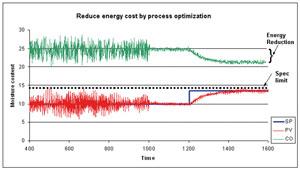|
PROCESS plants can make significant reductions in energy usage, with appropriate focus – not by making expensive process equipment changes, but simply by ensuring the optimum performance of existing equipment, operations and controls. Using the techniques in this article, it is typical to see energy savings from 0.5 percent to two percent of total energy cost, with some plants seeing as much as 20 percent reduction. To save energy, first identify the parts of the plant that consume the most energy. Consider fuels, steam, electricity, chilling/refrigeration systems and compressed air. If you find yourself thinking about boilers, reactors, drying, and separations operations, you are on the right track. These tend to be the most energy-intensive parts of a process plant. You probably know how much energy you use and even your energy spending per unit of production – it is common to see charts of fuel efficiency percentages and $/ton. But knowing how much you have spent doesn’t tell you how to spend less! To understand how to spend less on energy, you must measure the right short-term performance measures. The Opportunity Gap is one of the best ways to find process improvements and can be defined as “the opportunity to move the setpoint closer to the specification limit”. To use the opportunity gap, focus on identifying and removing sources of short term variability in your plant. As you do this, you can start to move your operating setpoints closer to their product tolerance limits. When looking at temperature, air/fuel ratio, moisture content, and steam pressure, cycles are major problems for energy efficiency – and removing oscillation is the first step in closing the opportunity gap. Oscillation detection technology will automatically identify, measure, and analyze the cycles in your plant. A Performance Supervision System identifies common causes of cycles and traces them back to their root cause. Whether the cause is equipment, controls or process operations, eliminating the cycle will improve energy efficiency and help to stabilise the operation. In studies of plant operations we have found that it is typical for 40 percent of measured variables to be cycling! Don’t forget that the control room is connected to some actual equipment, and equipment wears, leaks and breaks. When these things happen, the process again loses efficiency. There is no substitute for a good predictive and preventive maintenance program supported by a performance supervision package. Control valves are everywhere in process plants. In more than 20 years of studying control valve performance, we have discovered that 35 percent of control valves in plants have serious problems. It doesn’t matter how good your operators and control systems are if the valves don’t work! So to improve the process, focus on the valves. Some of the key measures are valve travel, hysteresis (aka ‘lost motion’), stiction (and oscillation due to stiction) and valve size (over-sized or under-sized?). More equipment issues Pay close attention to each piece of equipment that consumes energy – for example: dryers, heat exchangers, columns and boiler drums. When you measure and track a dynamic model of each piece of equipment, you will be able to detect fouling, plugging, blown seals, and other factors with a direct impact on energy consumption. In the past this has required substantial engineering calculations. Today, this can be accomplished automatically with Active Model Capture Technology. This technology works by monitoring the process continuously, 24 hours a day. It looks at process changes created by setpoint changes, mode changes, and disturbances to develop a dynamic model of process behavior. This model includes a wide variety of fundamental and performance-based parameters. Control system performance Ultimately, the job of the control system is to reduce plant variability. As we have seen above, oscillation and other variability leads to inefficiency. Poor controller tuning is another source of variability in plants. If a controller is tuned too sluggishly, then it does a poor job of responding to upsets. Tuned too aggressively, the controller will actually increase variability in the plant. |
There are, of course, many more ways to assess and improve controller performance. You could look at traditional measures, such as Integral Absolute Error (IAE), the Harris Index, Relative Response Time, and many others. All of these measures are available in a full-featured performance Supervision System. Now that you know what to look for, you need some tools to sort through all the data. With a Performance Supervision System you can gather all of this information directly from your existing control system.
A TreeMap allows you to quickly identify where to focus. Each control loop is represented by a coloured rectangle. The larger the rectangle the more important the control loop. The colour of the rectangle indicates the extent of oscillation. The TreeMap can be customized to show whatever performance data you wish to see, and quickly find the root cause of any issue in your plant. For example, set the rectangle size to “Economic Importance” and the colour to “Oscillating”, and you will know where to focus your efforts to reduce oscillations.
A Process Interaction Map is a way to graphically identify interactions in your plant. Choose any measurement in the plant, and the Map will show which other systems are interacting with it, at which frequency, and to what extent. Since the data is gathered automatically, 24 hours a day, there is no need to establish special studies to gather data, or perform bump tests. Just bring up the display and see the results. To find energy savings, you must look in the right place and measure the right things. A Performance Supervision System, such as PlantTriage, will automatically gather the right information from your control system, prioritize, and make it easy for you to pinpoint the biggest opportunities. Article by George Buckbee, director of product development at ExperTune, Inc and Rob Lyon of Lyon MacIntyre Ltd. Email: rob@lymac.co.nz
|








